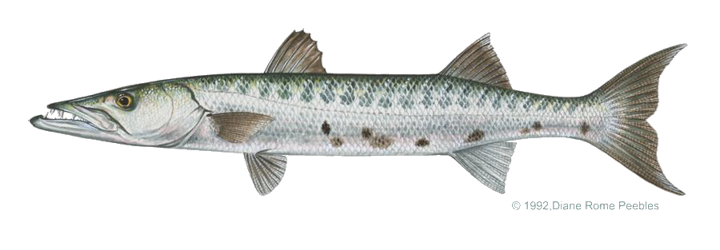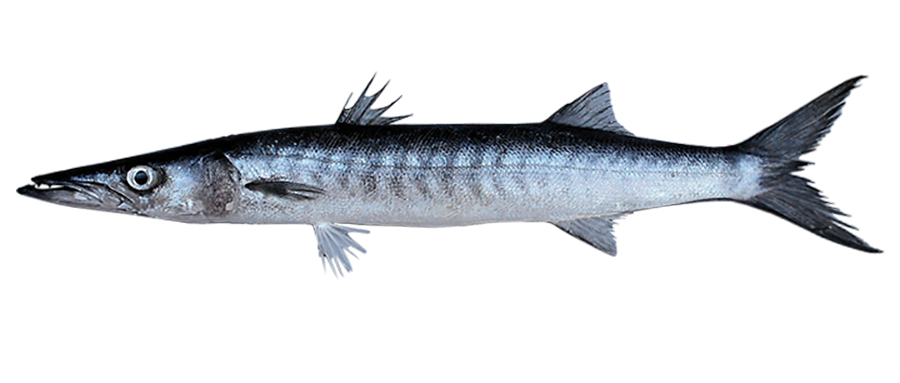Game Fish Identification Reference Guides
Barracuda, great
(Sphyraena barracuda)
(Sphyraena barracuda)

(Walbaum, 1792); SPHYRAENIDAE FAMILY; also called cuda, sea pike, giant sea pike
Occurs in all tropical seas except the East Pacific. Found offshore and inshore around reefs, piers, wrecks, sandy and grassy flats, and wherever smaller fish congregate. Smaller barracudas sometimes school, but the large ones are almost invariably loners.
The first dorsal fin has 5 spines; the second, 10 soft rays. The first rays of the second dorsal and anal fins reach to or beyond the tips of the last rays when the fins are depressed. There are 75 90 scales along the lateral line. The preopercle is rounded. The maxilla extends back as far as the eyes. The adult great barracuda has irregular black blotches on the lower flanks, especially near the tail. It is the only species of barracuda that has blotches.
The barracuda eats whatever is available. Its habit of “tagging along” with divers while opening and closing its mouth has given more than one diver the faith to walk on water; nevertheless, barracudas do not usually attack unless speared or provoked. The barracuda should be regarded as dangerous because of its ability to inflict serious injury, in or out of water.
Fishing methods include trolling with plugs, spoons, and prepared baits; live bait fishing with small fishes; casting and retrieving live and strip baits as well as plugs and spoons. The cast should not land too near the barracuda, but should be retrieved past it at a fast, erratic speed.
The great barracuda leads a list of tropical marine fishes suspected of causing ciguatera poisoning when eaten. The poison is caused by a microscopic plant (a dinoflagellate organism) eaten by smaller fishes and passed on in the food chain. The toxin can only be detected in laboratory tests
Occurs in all tropical seas except the East Pacific. Found offshore and inshore around reefs, piers, wrecks, sandy and grassy flats, and wherever smaller fish congregate. Smaller barracudas sometimes school, but the large ones are almost invariably loners.
The first dorsal fin has 5 spines; the second, 10 soft rays. The first rays of the second dorsal and anal fins reach to or beyond the tips of the last rays when the fins are depressed. There are 75 90 scales along the lateral line. The preopercle is rounded. The maxilla extends back as far as the eyes. The adult great barracuda has irregular black blotches on the lower flanks, especially near the tail. It is the only species of barracuda that has blotches.
The barracuda eats whatever is available. Its habit of “tagging along” with divers while opening and closing its mouth has given more than one diver the faith to walk on water; nevertheless, barracudas do not usually attack unless speared or provoked. The barracuda should be regarded as dangerous because of its ability to inflict serious injury, in or out of water.
Fishing methods include trolling with plugs, spoons, and prepared baits; live bait fishing with small fishes; casting and retrieving live and strip baits as well as plugs and spoons. The cast should not land too near the barracuda, but should be retrieved past it at a fast, erratic speed.
The great barracuda leads a list of tropical marine fishes suspected of causing ciguatera poisoning when eaten. The poison is caused by a microscopic plant (a dinoflagellate organism) eaten by smaller fishes and passed on in the food chain. The toxin can only be detected in laboratory tests














